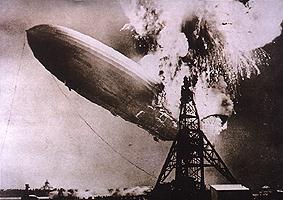Zepplin
Bubble or Balloon?
This coming autumn the Kunsthal Rotterdam. in a documentary
exhibition featuring the zeppelin. will highlight one of the
most heroic chapters of aviation history. It is a story full
of romance and danger, starting with the first generation of
zeppelins of around 1900 and ending with the Hindenburg's disastrous
last flight in 1937 - captured for posterity by a live radio
broadcast. This exciting story is retold in the form of photo
and film material. scale models and original documents and objects.
As well as presenting historical material. the exhibition focuses
on an aspect of topical interest. In view of the virtual impossibility
of predicting and coping with the increasing need for mobility
and the growth in commercial transport. a number of countries
are currently developing initiatives. One idea that could help
solve the problem is becoming an attractive proposition: the
airship. better known as the zeppelin or. as professional jargon
has it. the LTA (Lighter Than Airship). As welt as a technical
challenge. this revived and modernized form of aviation offers
tremendous advantages to the environment. The exhibition provides
an insight into the latest developments and possibilities of
the zeppelin and answers such questions as: why can't a new zeppelin
catch fire?

The zeppelin is back
Industry at home and abroad has discovered the potential of this
new form of transport. A number of companies are considering
ways and means of combining an old concept with advanced technology.
Various research projects have convinced the Dutch government
of the commercial viability of airships. Before the year is up.
these giants of the air wilt be seen above Rotterdam during tests
for an airship destined to support police activities during the
European football championships in 2000.
An environmentally friendly alternative
The old airships were fueled by highly inflammable hydrogen.
which in the modem generation is replaced by helium. a non-flammable
gas that is lighter than air. The zeppelin will run on smaller.
more economic diesel engines than its ancestor. and perhaps even
make use of solar energy one day. The skeleton and skin are made
of lightweight synthetic material. Flying at a speed of 150 kilometres
per hour. the zeppelin is not only a clean but a quiet alternative.
no more harmful to the environment than an intercity train. Because
an airship does not need long approach routes. complicated and
expensive infrastructures are unnecessary. A zeppelin can be
used to reach problematic or remote locations like the Holland's
West Frisian islands. oil-rigs or polar regions. It can hover
in the sky and is thus ideal for scientific research and traffic
observation. Airships can also provide efficient help in nature
disasters, in Third World countries and in tracing landmines.
The world of transport sees possibilities for large-volume and
problematic transport operations. Last but not least, the zeppelin
opens up new horizons for tourism: with its leisurely speed and
fantastic views, it is nothing less than a flying cruiser!
|
